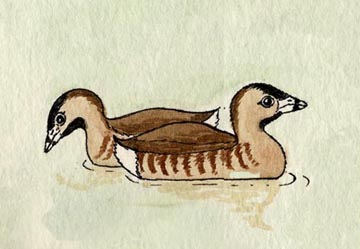

In the summer, they are found throughout North America south to northern South America. In the winter, they migrate to the southern U.S., the Caribbean and South America.
They live on ponds, lakes and coastal marshes that are edged by cattails or reeds.
In the summer, they are dark brown on top and lighter below with a light grayish-tan neck and flanks and a white rump patch. They have a black throat patch that extends to the cheeks. They have dark eyes surrounded by a white ring. They have a blunt bill with a black, vertical bar. They reach about 15 inches (38 cm) long. The have lobed toes instead of webbed feet.
They dive underwater for feeding and to escape predators.
They eat crayfish, water insects and small crustaceans.
Females lay up to 10 pale blue eggs in a nest of woven water plants built to float on the water and sheltered in tall reeds or cattails. Chicks will seek shelter in the nest for many days, but will join their mother on the water by riding on her back.
Kingdom: Animalia
Phylum: Chordata
Subphylum: Vertebrata
Class: Aves
Order: Podicipediformes
Family: Podicipedidae
Genus: Podilymbus
Species: P. podicep
When you research information you must cite the reference. Citing for websites is different from citing from books, magazines and periodicals. The style of citing shown here is from the MLA Style Citations (Modern Language Association).
When citing a WEBSITE the general format is as follows.
Author Last Name, First Name(s). "Title: Subtitle of Part of Web Page, if appropriate." Title: Subtitle: Section of Page if appropriate. Sponsoring/Publishing Agency, If Given. Additional significant descriptive information. Date of Electronic Publication or other Date, such as Last Updated. Day Month Year of access < URL >.
Amsel, Sheri. "Grebe (Pied-billed)" Exploring Nature Educational Resource ©2005-2024. December 14, 2024
< http://www.exploringnature.org/db/view/Grebe-Pied-billed >

